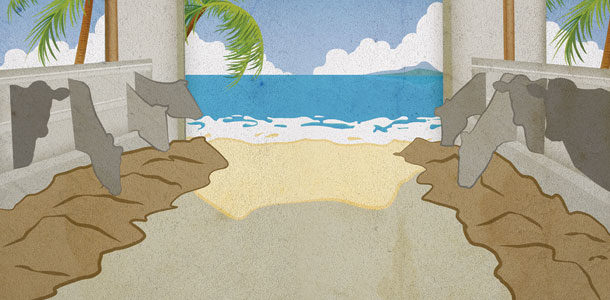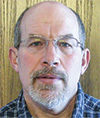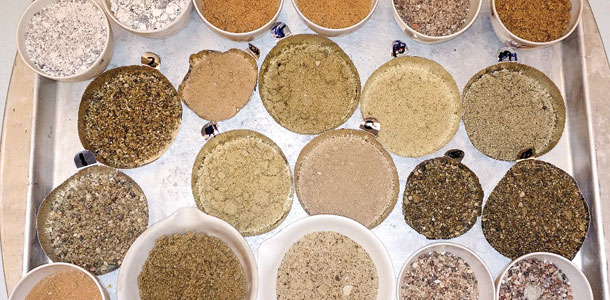From Florida to California or the Riviera to Rio, from white fine sugar to black or “green,” locations around the globe claim to be the home of the “best beach in the world.” All of their claims to fame center on one compound: sand. Yet, the diversity of sand along oceans, lakes and rivers is astounding.
When looking at dairies, we often say the word “sand,” and we claim to use “sand” in our facilities, but the same diversity that exists along the waterfront also exists in our dairy operations around the country and around the world.
So what would make the best dairy cow “beach” (or stall) in the world, and how can you examine, gauge and assure success considering the diversity of the sand supply?
What is sand?
Most of us have a vision of what sand is to us. According to the encyclopedia, sand is a naturally occurring granular material composed of finely divided rock and mineral particles. It is defined by size, being finer than gravel and coarser than silt.
The most common sand is silica (typical beach-type sand); the second most common is calcium carbonate (limestone). Finding pure silica or limestone sand is often difficult, and the diversity of sand compounds multiplies as other granular sizes are mixed in.
Sand also varies in coarseness from very fine bluff or “candy” sand to very coarse. The composition and coarseness impacts animal comfort, cleanliness and organism growth. Pebbles and stones are contaminants and can create foot and other problems.
As you can see (Photo 1), many “pebbly” or “rocky” materials are being sold as “sand” to dairy producers, and many of these provide a pretty poor beach (or stall) for your dairy cows.
Sand properties– the good, bad and ugly
Understanding sand properties and proper sand management is critical to choosing and successfully using sand as a dairy bedding material.
The good
Sand is:
- Inorganic, which means sand itself can’t grow micro-organisms like bacteria.
- Not absorbent, which means it does not take in or swell with moisture.
- Very dense, which gives it the “cushioning” or comfort properties dairy producers desire as long as there are no contaminants like stones or sharp objects in the sand.
Many people then think clean sand that drains moisture properly is always comfortable and rarely associated with mastitis. But that’s a big fallacy. Composition, density, grooming, organic matter and moisture all play a part in the relative success of a sand system.
The bad and the ugly
- Small granules and density create challenges and risks that need to be managed closely and continually. All sand holds water in between the granules, and the finer and denser the sand, the more moisture is held by capillary action, even if the sand is reasonably clean. (The normal range is 3 to 6 percent moisture).
Also, by having a large surface area (small grains) and small channels to trap organic matter (OM) between sand particles, it is easy to form an organic biofilm which slows down water percolation or drainage and fuels organism growth (greater than 3 percent OM, or 2 percent in very fine sand).
How to ensure youhave good-quality sand
Most people want to know the organism load, as they are worried about mastitis, and some labs perform this.
While knowing the number seems important, it doesn’t provide a full picture. Organism load is often reported as colony-forming units (CFU), or organisms per gram of bedding. Since sand is dense, there are a lot of grams under a cow’s udder; volume must be considered in assessing overall organism load. But organisms themselves aren’t the problem unless you add water (moisture) and fuel (organic matter, like manure) to their environment.
Testing for CFU of organism load isn’t going to assess your true risk. Instead, the two key critical components to measure are dry matter (DM; or its reverse, moisture) and OM. These are what my lab at Iowa State and other quality labs measure.
My goals for “the best sand beach” are:
- Consistency in sand composition
- Low coarseness
- Lowest values for DM and OM – Target less than 3 percent for OM (ideally, less than 1 percent). While it is difficult to assign a clear-cut value for DM, the rule is: Drier is better. These seem like fairly tight restrictions, but 1 percent by weight of something as dense as sand is a lot of water or contamination.
How to sample sand for lab testing
Consider all areas you want to test (fresh, purchased sand; fresh, recycled sand off of a lane or separator; sand piles; stall areas or pens including dry and transition cows).
- Collect a representative sample by following these steps:
- Take 10 to 20 grab samples from a single area.
- Mix them in a 5-gallon bucket.
- Draw a sample and fill a 1-quart freezer bag one-third full. (Note: The more sand you send, the higher the testing cost.)
- Label the bag with the area it came from.
- Repeat for other areas in the facility.
Samples for DM and OM testing do not need to be frozen or shipped overnight. To get organism numbers (CFU), you will need to freeze the sample and send overnight. (This is very costly with little gained information.)
I dry samples at 1,000ºF for 24 hours to measure DM and then at 6,000ºF for 12 hours for OM. What you end up with is the base sand compound, reverse calculating for the volume of each in the original sample.
Surprising findings and results
- First surprise: As shown in the photo, it’s amazing what people buy and use and call sand. If you’re buying sand, don’t skimp on cost. Buy high-quality, clean sand. I find a lot of herds buying sand-like materials or sand with greater than 3 percent OM (dirty sand).
- Second surprise: Most sand being recycled through a properly functioning sand separator or sand lane is often as clean or cleaner than original sand. But, on the other hand, a bad separation system means higher OM and certainly lower DM, which is a recipe for disaster.
- Third surprise: Even with a single sand source, there can be widely different values in the different sand areas on the farm. Nearly 90 percent of farms I test, both lactating and dry cow/prefresh heifer pens, show higher OM and moisture in transition areas, a place of higher risks for animals and a suggestion these stalls get less attention.
My rule is this: Test; don’t guess.
Keys to a successful ‘beach’
A successful beach for cows is comfortable, clean and dry.
Start with a quality, clean and reasonably dry sand (test; don’t guess), whether buying fresh or recycling, and commit to consistent and thorough stall management year-round.
- Comfort is somewhat inherent in the density and cushion of sand; however, an ungroomed or improperly filled or groomed stall means sharp, rough curb edges (hock and leg abrasions) or, when low enough, lying ahead of the curb (dirty stalls).
Research from the University of British Columbia shows 11 minutes less lying time for every one-third of an inch that sand gets below the curb. That’s 30 minutes less lying per day when you’re low just 1 inch.
- Cleanliness is a result of proper stall grooming and proper stall sizing. Ensure proper stall fit; remove wet, dirty material at each milking; scrape alleys to minimize foot contamination; and because stalls eventually build up OM, dig out the back 12 inches every one to six months and replace with fresh, clean sand.
- Dryness is influenced by quality of sand to start, proper grooming or raking to remove wet areas, and “aerating” the top sand. Even if the sand supply you have has high OM (greater than 4 percent), it is possible to manage organism growth by managing moisture through excellent raking and aeration. Remember, OM has the greatest influence on moisture, drainage and organism growth.
For many, sand is the gold standard for bedding in terms of animal comfort and disease control, and it is an excellent choice. However, some of sand’s properties amplify risks if the sand quality is poor or the stalls are not properly managed.
For many, the risks and challenges of using sand, from finding or producing a high-quality sand, justifying the cost to ensure consistent and thorough stall maintenance, and the impact on the manure system, have drawn some producers to alternative stalls and bedding surfaces.
Regardless of the bedding choice, comfortable, clean and dry are the goals. Every bedding type has its own benefits and risks, but it is critical to remember that no stall bedding is free – every one must be maintained to ensure cleanliness and dryness.
Commit to comfort by committing to properly manage your bedding surface on a regular basis. PD
ILLUSTRATION: Illustration by Kristin Phillips and Sarah Johnston.
PHOTO: The wide variety of dairy bedding sand samples sent for testing to Iowa State University’s lab illustrates the diversity and challenges of sand management. Photo courtesy of Leo Timms.

-
Leo Timms
- Dairy Extension Specialist and Morrill Professor
- Iowa State University
- Email Leo Timms









